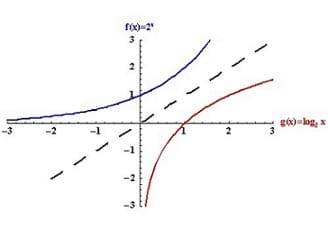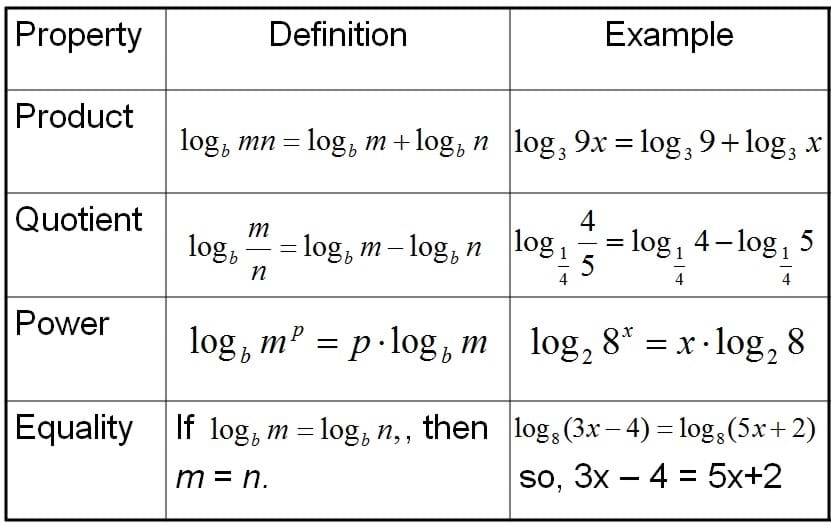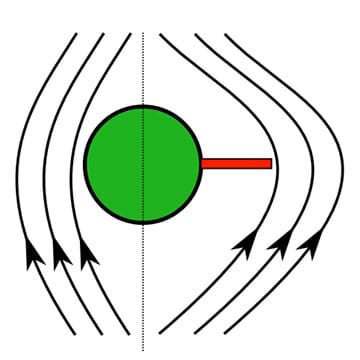Quick Look
Grade Level: 11 (9-12)
Time Required: 1 hours 45 minutes
(two 50-minute sessions)
Lesson Dependency:
Subject Areas: Algebra

Summary
In their reading from activity 1 of this unit, students should have discovered the term "logarithm." It is at this point that they begin their study of logarithms. Specifically, students examine the definition, history and relationship to exponents; they rewrite exponents as logarithms and vice versa, evaluating expressions, solving for a missing piece. Students then study the properties of logarithms (multiplication/addition, division/subtraction, exponents). They complete a set of practice problems to apply the skills they have learned (rewriting logarithms and exponents, evaluating expressions, solving/examining equations for a missing variable.) Then they complete a short quiz covering what they have studied thus far concerning logarithms (problems similar to the practice problems). They consider how what they have learned moves them closer to answering the unit's challenge question.Engineering Connection
Students learn the equation needed to calculate bone mineral density, which is a calculation that biomedical engineers make all the time. Through this lesson, students come to realize that they have not learned all the necessary math skills in order to calculate bone mineral density but gain the motivation to learn about logarithms.
Learning Objectives
After this lesson, students should be able to:
- Define logarithms as exponents.
- Rewrite logarithms as exponents and vice versa.
- Apply the properties of logarithms (products, quotient, power and equality) to solve equations.
Educational Standards
Each TeachEngineering lesson or activity is correlated to one or more K-12 science,
technology, engineering or math (STEM) educational standards.
All 100,000+ K-12 STEM standards covered in TeachEngineering are collected, maintained and packaged by the Achievement Standards Network (ASN),
a project of D2L (www.achievementstandards.org).
In the ASN, standards are hierarchically structured: first by source; e.g., by state; within source by type; e.g., science or mathematics;
within type by subtype, then by grade, etc.
Each TeachEngineering lesson or activity is correlated to one or more K-12 science, technology, engineering or math (STEM) educational standards.
All 100,000+ K-12 STEM standards covered in TeachEngineering are collected, maintained and packaged by the Achievement Standards Network (ASN), a project of D2L (www.achievementstandards.org).
In the ASN, standards are hierarchically structured: first by source; e.g., by state; within source by type; e.g., science or mathematics; within type by subtype, then by grade, etc.
Common Core State Standards - Math
-
(+) Understand the inverse relationship between exponents and logarithms and use this relationship to solve problems involving logarithms and exponents.
(Grades
9 -
12)
More Details
Do you agree with this alignment?
International Technology and Engineering Educators Association - Technology
-
Analyze how technology transfer occurs when a user applies an existing innovation developed for one function to a different purpose.
(Grades
9 -
12)
More Details
Do you agree with this alignment?
State Standards
Tennessee - Math
-
(+) Understand the inverse relationship between exponents and logarithms and use this relationship to solve problems involving logarithms and exponents.
(Grades
9 -
12)
More Details
Do you agree with this alignment?
Worksheets and Attachments
Visit [www.teachengineering.org/lessons/view/van_bmd_less2] to print or download.Pre-Req Knowledge
Students need to have already covered exponential functions.
Introduction/Motivation
Let's jump right into the equation that real-world engineers use to find bone mineral density. Do not be concerned about the many symbols and variables that you are unfamiliar with. I just want to give you idea of the larger picture of the unit. Once you see these equations, we will start in with logarithms by relating them to exponents, which is something that you are all familiar with.
Lesson Background and Concepts for Teachers
On Day 1, present to the class the BMD Math and Logarithms Introduction, a PowerPoint® file. Before starting, hand out the History of Logarithms Handout and Exponential Functions Graphs Notes for students to take notes on while you go through the presentation content.
On Day 2, present the Properties of Logarithms, another PowerPoint® file. Then at lesson end or as homework, assign students to complete the Log Properties Practice Problems, a sheet of practice problems. Also administer the Log Properties Quiz.

Conclude with a class discussion: How might what you have learned in this lesson apply to the challenge question? How much closer are you to answering the questions? What do you still have to learn?
Assessment
Practice Problems: At lesson end or as homework, assign students to complete the Log Properties Practice Problems. Review their answers to assess their depth of comprehension.
Quiz: Administer the eight-question multiple-choice Log Properties Quiz on logarithm properties. Review students' answers to gauge their comprehension.
Subscribe
Get the inside scoop on all things TeachEngineering such as new site features, curriculum updates, video releases, and more by signing up for our newsletter!More Curriculum Like This

Students continue an examination of logarithms in the Research and Revise stage by studying two types of logarithms—common logarithms and natural logarithm. They take notes about the two special types of logarithms, why they are useful, and how to convert to these forms by using the change of base f...

Students revisit the mathematics required to find bone mineral density, to which they were introduced in lesson 2 of this unit. They learn the equation to find intensity, Beer's law, and how to use it. Then they complete a sheet of practice problems that use the equation.

Students learn about nondestructive testing, the use of the finite element method (systems of equations) and real-world impacts, and then conduct mini-activities to apply Maxwell’s equations, generate currents, create magnetic fields and solve a system of equations. They see the value of NDE and FEM...
Copyright
© 2013 by Regents of the University of Colorado; original © 2006 Vanderbilt UniversityContributors
Kristyn Shaffer; Megan JohnstonSupporting Program
VU Bioengineering RET Program, School of Engineering, Vanderbilt UniversityAcknowledgements
The contents of this digital library curriculum were developed under National Science Foundation RET grant nos. 0338092 and 0742871. However, these contents do not necessarily represent the policies of the NSF, and you should not assume endorsement by the federal government.
Last modified: August 17, 2018








User Comments & Tips